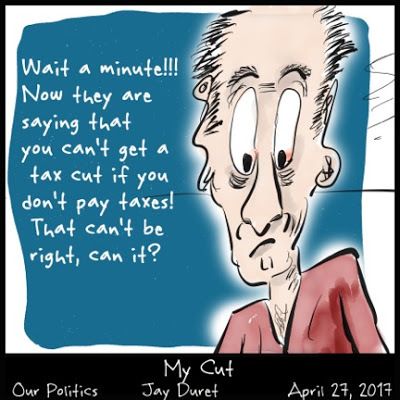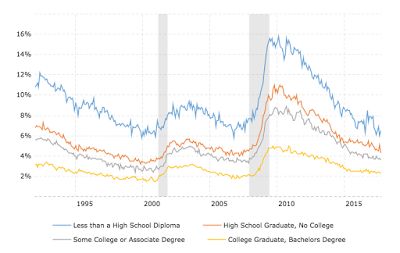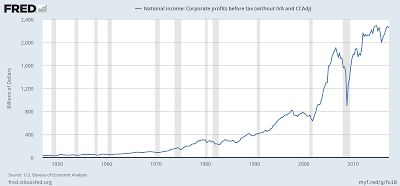Paul Ryan can call it tax reform all he wants, but Donald Trump is not fooled. Asked by Ryan and House Ways and Means chairman Kevin Brady to come up with a name for the bill, the branding wizard-turned-president replied with “The Cut Cut Cut Act.”
Donald Trump may be a long-time New York City Democrat, but once he decided to run for president, he picked up the Republican playbook and took it to heart. For the past several decades, the GOP election strategy has focused on a small number of high-impact issues―notably pro-gun, pro-life, religious liberty and the like―but none came to define the Republican brand as much as tax cuts. From the outset of his campaign, Trump promised “the biggest tax cuts ever.” Forget tax reform ― that is for policy wonks who were on debate teams in college. Tax cuts are an easy pitch to the Republican base in 140 characters or less.
According to Brady and Ryan, the legislation introduced this week is about delivering an estimated $1,200 in income tax relief to lower and middle class American families who are weary of the complexities and burdens of the tax code. It is notable, however, that the income tax rate for the “average” household with an income of $59,000 is approximately 2.6 percent. If the proposed increases in the standard deduction and tax credits go into effect, those families should end up with a negative tax rate―meaning that after tax credits they will get back more than they paid in. Lower-middle-class households already take out more than they pay in, as, before the proposed changes, the average income tax rate for the second quintile of households is negative 1.2 percent. The problem all along for GOP tax cutters promising middle class income tax relief is that the middle class―much less the lower middle class―barely pays the federal income tax.

Nonetheless, marketing the GOP plan as a tax cut for lower and middle class families is critical, even if it can be more accurately described as a welfare system that funnels cash to those households. There is nothing inherently wrong with this―cashflow relief is cashflow relief, after all―but in a country where disdain for the government and those who benefit from government programs has been carefully cultivated as a GOP Election Day strategy, some frank discussion might be in order. Some of the current anger in our politics toward people seen as takers and leeches on the system―central to the rise of Trump―might be lessened if many of those who are angry come to recognize that they too are getting help in getting by.
For weeks now, Paul Ryan has been defending the $1.5 trillion cost of the proposed tax cuts, insisting that there would be no negative deficit impact of the tax cuts. This, too, is central to the marketing of the plan. “We are convinced,” Ryan argued, “and the models are really clear, people will change their behavior, businesses will change their behavior if taxes change. That $1.5 trillion number is in the mid-range of the growth we expect. We believe that we will get faster economic growth that will exceed this $1.5 trillion. So we don’t anticipate a big deficit affect from this tax reform.”
The notion that there are models suggesting the deficit-neutrality of tax-cut legislation is widely derided among professional economists―Republicans and Democrats alike, with the notable exception of the usual collection of charlatans and cranks. Bruce Bartlett―one of the architects of Ronald Reagan’s original tax cuts―has for years railed against Republican revisionist history that those tax cuts―or any similar income tax cuts―pay for themselves. If Ryan has models that suggest otherwise, it is just a product of someone tinkering with the algorithm to get the desired result. However, given the anti-elite, anti-academe tenor of the moment, criticism from professional economists of legislation endorsed by this President will only add intensity to the support for the legislation among the Republican base.
No doubt, Ryan is looking to provide political cover for his members with his specious tax-cuts-pay-for-themselves rhetoric, but one has to wonder why. It seems unlikely that he will get much pushback in the Republican Caucus regarding the deficit impacts of tax cuts, for the simple reason that there is likely to be little pushback from the Republican base. An Economist/YouGov poll published last month suggested that 58% of Republicans now support tax cuts regardless of deficit impacts, as compared to 39% of Democrats, and one cannot imagine that Ryan intends to relay on support from across the aisle. Members of his caucus understand that passing tax cuts ― and preferably massive tax cuts as the President is demanding ― has become a political imperative, however the economics shake out.
Nonetheless, it is worth reflecting for a moment on the circumstances underlying the economic promises that are being made. First and foremost, all of the usual rhetoric about cutting spending to pay for tax cuts has gone by the wayside. In the current era of mob rule, few GOP members of Congress―including members of the Freedom Caucus who long claimed that their single reason for being in Washington was to end deficit spending―are likely to be swayed against the tax cut plan on account of another trillion dollars or two of borrowing. They have seen the price paid by those who go against the President and they want no part of it. Furthermore, as the graph below illustrates, for the past half-century, federal outlays have hovered around 20% of GDP, regardless of spending caps and sequesters, tax policies and rates. Spending moderated slightly during the Reagan and Clinton years, while rising a bit during both Bush presidencies. It spiked upward when GDP dropped in the wake of the 2008 financial crisis, before trending back down to 20% as the economy recovered. If anything, spending is likely to trend upward over the course of the current administration, given the President’s interest in growing both military and infrastructure spending, and his lack of interest in entitlement reform. Faced with those facts―and the overriding political imperative of producing a tax cut bill―Ryan is choosing the only path forward available to him if he is to give a nod to fiscal prudence: a “model” that shows that cutting taxes will not reduce revenues.

Second, the national unemployment rate of 4.1% is currently near the lowest level in a half-century. This begs the rationale for massive tax cuts, which are traditionally seen as an economic tool for stimulating growth at times of high unemployment. Donald Trump and House Republicans have been particularly vocal about the urgency of boosting economic growth above the current 3% range. The simple fact is that the United States economy is outperforming much of the advanced industrial world in its recovery from the 2008 global financial collapse, though in the current climate of anger and complaining few are inclined to stand their ground on how well things are going.
Many people have argued--as the President did when he was a candidate--that the official "U-3" unemployment rate understates the employment challenges facing the economy. Those people often point to the higher "U-6" rate that includes underemployed and "marginally attached" workers. The U-6 rate spiked at around 17% in the aftermath of the 2008 collapse, and now hovers around 8%. This is not unusual, however, as the graphic below illustrates. The U-6 rate has always floated somewhat above the official rate, with a spread to the U-3 rate that widens as economic conditions worsen and narrows as things improve; with a steadily improving economy, the spread between the U-3 rate and the U-6 rate is now narrowing exactly as one would expect. The truth is that companies across the country already cannot find workers. These tight labor market conditions beg a simple question: where are all the excess workers supposed to come from if tax cuts pass and the economy heats up further. Trump boasts about the lowest unemployment rate in nearly a half century and seems oblivious to the implications of that statement for his tax cut promises of new jobs.

Third, the most significant factors affecting individual employment prospects and family income sustainability remain largely within the domain of individual choices made over the course of a lifetime. Educational attainment and the willingness to relocate for economic opportunity have long been the primary determinants of economic well-being, and have been central to long-standing GOP principles of self-reliance and personal responsibility. One of the tragedies of the rise of Trump as the avatar of the new Republican Party has been his willingness to undermine the importance of that message, both encouraging workers to stay where they are and rely on him to bring their jobs back, and contributing the growing Republican disdain for higher education. As the graph below illustrates, the linkage between educational attainment and family incomes and economic resiliency is clear. In his book Hillbilly Elegy--which became a bible of sorts for Republican understanding of the plight of its rural white working class base voters--J.D. Vance observed that his family members who went back to school or moved to regions of the country with better job prospects both fared well, while those who stayed put in eastern Kentucky and blamed others for their fate did not. When considering their plight, he suggested that they only needed to look in the mirror to find the source of their problems.

Finally, there is the "jobs" element of the Tax Cuts and Jobs Act: the corporate income tax cuts. This element of the tax cut plan can perhaps best be described as a solution in search of a problem. The prospect of corporate tax cuts--along with a relaxing regulatory environment--have sparked a dramatic rally in the stock markets and galvanized support across the business community for the Trump administration. But unlike flagging household incomes, corporate profits are already at historically high levels in both absolute dollars and as a share of national income, as illustrated here. The prospect of a reduction in the statutory corporate tax rate from 35% to 20%, as well as a tax holiday on overseas profits and full expensing of capital investment, only looms to bolster further profit growth.

The jobs argument for the proposed tax cuts centers on the administration's contention that corporate tax cuts will translate into increased worker wages. Specifically, they are arguing that the proposed $200 billion corporate tax cut will produce a $4,000 to $6,000 hike in average worker take-home pay. Looking at the low end of the projection, $4,000 per worker pencils out to $400 to $600 billion annually, or two or three times the value of the proposed tax cut. The presumption is that with a new, lower statutory tax rate, global capital will pour into the United States, manufacturing will be reborn, and, ultimately, employee wages will be bid upward. After decades of seeing wages decline as a share of national income--as illustrated here--America will be made great again.

That analysis has sparked a raging debate among economists, both as to the basic premise that corporate tax rate cuts lead to meaningful wage increases--which is largely based on experiences of small economies--and historical evidence that suggests that the primary beneficiaries of past corporate tax cuts tend to be shareholders and corporate CEOs and board members. As The Economist magazine pointed out, the administration analysis also seems to ignore the interaction among various provisions in the proposed legislation. Allowing the full expensing of capital equipment--combined with continued, historically low interest rates--may be the real game changer, rather than the cut in the statutory tax rate. Companies faced with tight labor markets will have every incentive to invest in robotics and artificial intelligence to reduce their overall need for workers, rather than boosting their pay, producing an effect at odds with what the administration is promising
But this is all conjecture, and should not be an obstacle if the GOP keeps its eye on the prize. Even if the economics have not always played out as predicted, tax cuts have always worked as a political strategy. That is where the real algorithm lies, in the politics.
Follow David Paul on Twitter @dpaul. He is working on a book, with a working title of "FedExit: Why Federalism is Not Just For Racists Anymore."
Artwork by Jay Duret. Check out his political cartooning at www.jayduret.com. Follow him on Twitter @jayduret or Instagram at @joefaces.
